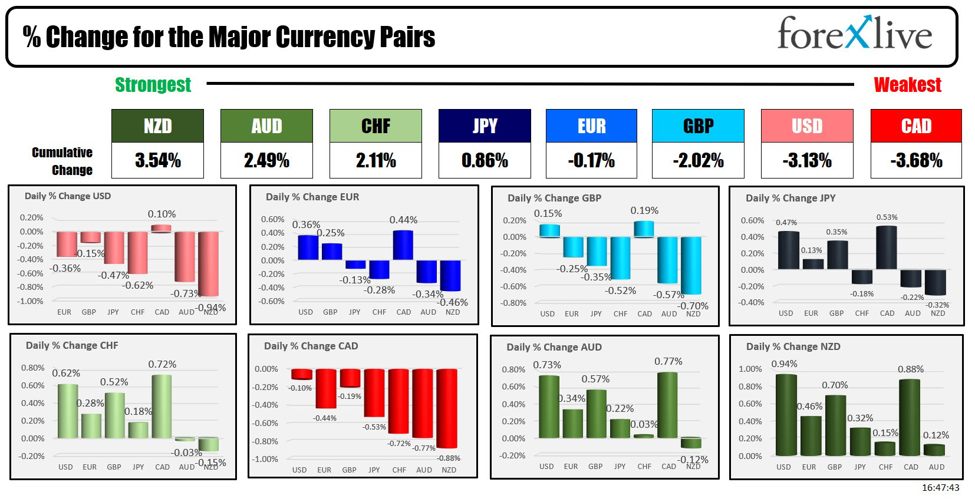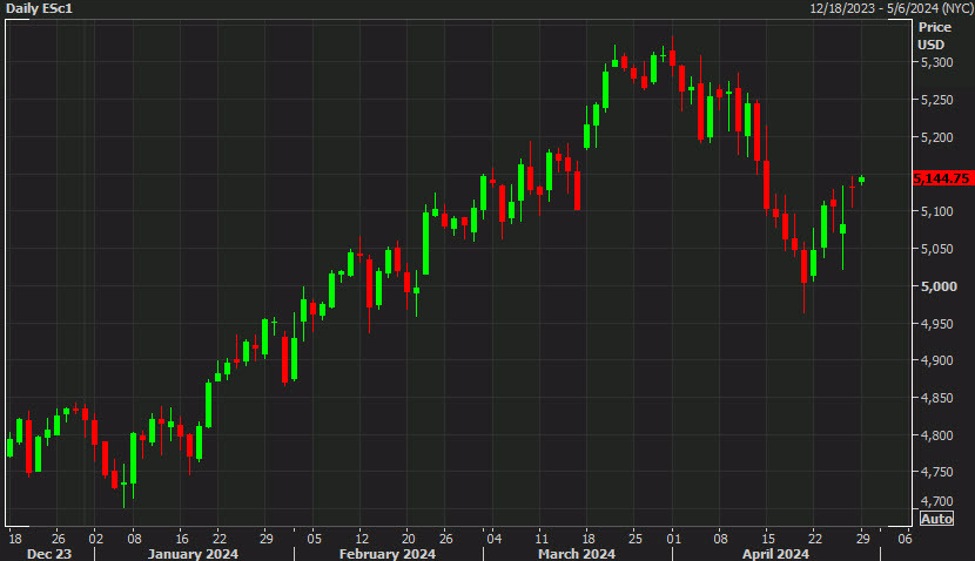- Major US indices close higher for the day and the week
- What key earnings are on the calendar for the week starting May 6
- Oil falls $5.50 on the week as a head-and-shoulders pattern forms
- Credit Agricole: Japan has succeeded in generating asymmetric risks around USD/JPY
- Why a Tesla breakthrough in full-self-driving would be a fleeting victory for TSLA stock
- Baker Hughes US oil rig count 499 vs 506 prior
- European equity close: A silver lining to a tough week
- Goldman Sachs still thinks a July rate cut is more likley
- Fed’s Goolsbee: Jobs reports like this will give us confidence the economy not overheating
- Japan fin min Suzuki: Rapid currency moves are undesirable as they would hurt households
- ISM April services index 49.4 vs 52.0 expected
- Fed’s Bowman: Baseline outlook still that inflation will decline with rates steady
- S&P Global final April services 51.3 vs 50.9 prelim
- S&P Global Canada April Services PMI 49.3 vs 46.4 in March
- Kickstart the FX trading day (post NFP) with a technical look at EURUSD, USDJPY, GBPUSD.
- Why this could be just the beginning for the downturn in jobs
- US average hourly earnings MoM 0.2% versus 0.3% expected. YoY 3.9% vs 4.0% expected.
- US March non-farm payrolls +175K vs +243K expected
- ForexLive European FX news wrap: Dollar lags in run up to US jobs report
- The CHF is the strongest and the USD is the weakest as the NA session begins
The US employment data for the month of March came in less than expectations at 175K vs 243K estimate. The prior month was revised higher to 315K from 303K previously reported. The unemployment rate did take up to 3.9% from 3.8% while average hourly earnings came in at 3.9% YoY, the lowest level since 2021. The average workweek also dipped to 34.3 from 34.4 last month.
Information jobs fell -8kProfessional and business services showed a decline for the month of -4K. Other relatively weak sectors included Government (+8K), financial activities(6K), leisure and hospitality (+ 5K) and construction (+9K).
Goods-producing jobs only added 14K while private service producing jobs added 153K led by a 95K rise in education and health.
The data is just for one month. The Fed Chair hinted after the Fed meeting that it would need to take a slowing in the US job market to help convince the Fed that growth and inflation was likely to ease further. The Fed Chair this week did speak a little less hawkishly then expectations saying that a hike was not likely (for now at least). There was worry of the Fed moving toward a more symmetrical policy stance.
The report today allowed for a sigh of relief, but will need to be followed by signs that inflation is abating and that job growth is indeed coming off the burner.
Later today, the ISM Non-Manufacturing prices paid component did not help as it rose to 59.2 from 53.4 last month. Report on CPI and PPI later this month will be of importance once again.
In other news, the muzzle on other Fed officials was taken off today with Fed Gov. Bowman and Chicago Fed Pres. Goolsbee both speaking after the US jobs report.
Federal Reserve Governor Michelle Bowman (more of a hawk) lamented on the complexity of managing inflation and interest rates amidst varying economic indicators. She emphasized that while inflation is expected to decrease with current interest rates, the Federal Reserve remains open to further rate increases if inflationary trends do not improve or if they worsen.
Bowman pointed out several potential risks that could negatively affect economic forecasts, including uncertainties about whether improvements on the supply side will continue to help reduce inflation. Additionally, factors such as strong consumer demand, higher immigration, and a tight labor market could persistently drive up core services inflation. She also noted that any fiscal stimulus might boost consumer demand further, complicating efforts to control inflation.
Despite challenges posed by significant data revisions in recent years, Bowman highlighted the flexibility of monetary policy, stressing that it is not on a predetermined path and that decisions will be tailored to the latest economic data.. She reaffirmed the importance of restoring price stability to support long-term employment goals.
Later, Federal Reserve official Austan Goolsbee expressed confidence that the economy is not overheating, as evidenced by job reports resembling pre-COVID conditions. Goolsbee acknowledged a temporary inflation spike earlier in the year but suggested that consistent job growth without overheating could indicate the economy is stable. He also noted the need to reevaluate the job market dynamics in light of higher immigration rates and the absence of supply chain bottlenecks, which had previously been a concern. Additionally, feedback from manufacturing business contacts suggests a stable economic environment.
Goolsbee emphasized the importance of balancing restrictive monetary policies to avoid negatively impacting employment, indicating that the Federal Reserve is carefully monitoring these developments to ensure they align with long-term economic stability and inflation control.
The Goldilocks-ish data today did help to propel US stocks sharply higher, US yields lower and the USD lower.
Looking at the closing levels for stocks, with the three major indices all rising by over 1% (and the NASDAQ nearly 2%). The Russell 2000 index of small-cap stocks rose by just under 1% (0.97%).
- Dow Industrial Average average rose 1.18%
- S&P index rose 1.26%
- NASDAQ index rose 1.99%
- Russell 2000 rose 0.97%
All the major indices rose for the week with the NASDAQ up 1.43% and the Russell 2000 up 1.68% leading the way.
In the US debt market, yields were lower but off their lowest levels at the close>
- 2-year yield 4.805% after trading as high as 5.046% this week. For the week, the 2-year yield fell -18.0 basis points
- 10 year yield 4.497% after trading as high as 4.695% this week. For the week, the 10 year yield fell -15.5 basis points.
- 30-year yield 4.660% after trading as high as 4.800% this week. For the week the 30-year yield fell -11.0 basis points
Today in the Forex market, the NZD and the AUD were the strongest of the majors on risk-on flows. The CAD and the USD were the weakest of the major currencies.
For the trading week the DXY index fell -0.958%
Versus the majors, the USD fell:
- -0.63% versus the EUR
- -0.45% versus the GBP
- -3.38% versus the JPY
- -1.03% versus the CHF
- -1.18% versus the AUD, and
- -1.24% versus the NZD
The greenback was up 0.12% versus the CAD this week
Things quiet down next week as the earning calendar gets lighter. Only Nvidia on May 22 is a potential large market mover.
On the events and economic release calendar:
- Reserve Bank of Australia interest rate decision on Tuesday. No change expected
- US 10 year note auction on Wednesday
- Bank of England rate decision on Thursday. No change expected
- US 30 year bond auction on Thursday
- UK GDP on Friday
- Canada employment statistics on Friday
- US Michigan consumer sentiment preliminary on Friday
This article was written by Greg Michalowski at www.forexlive.com.
Source link




